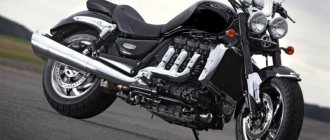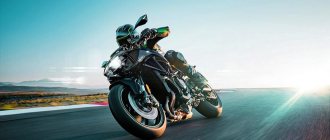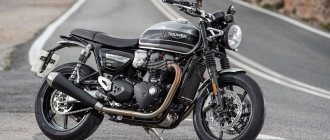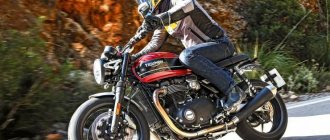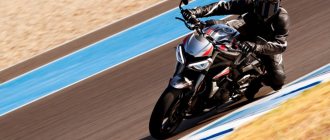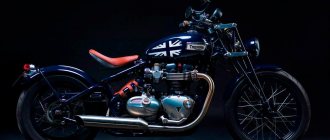When a selection of heavy modern production motorcycles came out, questions began:
— Where is Triumph Rocket 3?
— Why isn’t Triumph Rocket 3 here?!
How to continue to live if there is no Triumph Rocket 3?! But, firstly, the weight of the new product does not even reach three hundred kilograms. Secondly, I’ll be honest, half the world somehow lives quite well without this motorcycle, provided that its target audience is difficult to define. The motorcycle is unique - not for everyone. Some people, when they see his characteristics, deny:
- Why do I need so many motorcycles? Where to put all his passion?
But the Triumph Rocket 3 is worthy of a separate article with a review, although it cannot be called the heaviest production bike, but the engine performance arouses much more curiosity. Moreover, the new 2022 product is undoubtedly among the top expected motorcycles.
So, meet the largest production roadster, aka the “ultimate musclebike”!
Loud update
In fact, this is not one motorcycle, but two. In mid-2019, Triumph announced an update of two 2022 models - Rocket 3 GT and R. According to Triumph, the modern Rocket 3 R and GT are considered the most technologically advanced factory roadsters, the pinnacle and perfection of the company.
The manufacturer is pleased to announce that both motorcycles have the largest production engine in the motorcycle industry - a 2.5-liter (2458 cc) inline three-cylinder liquid cooled engine. Peak power is 167 hp. at 6000 rpm, which is 11% better than the previous generation engine.
To lighten the engine's weight and reduce vibration, new balancer shafts have been created. Engineers have revised the dry sump lubrication system and a separate oil tank. We see a hydraulic slipper clutch.
The new product is equipped with a six-speed gearbox. Let us remember that the predecessors had only five gears.
An exhaust system with a three-in-one-in-three hydroformed manifold structure with a catalyst allows the powerful engine to breathe. And the air intake located in front helps the engine breathe.
All this promises disruptive engine features, traction capabilities and decent acceleration dynamics.
Rocket 3 on a diet
The new Rocket 3 has shed as much as 40 kilograms, making it 13% lighter than the previous model.
The motorcycle sits on a new aluminum frame, which features lightweight cast and forged components. Due to the structure, weight distribution is achieved, as well as the center of gravity located as low as possible. Features include a cantilever swingarm and a side-mounted mono shock absorber.
The motorcycle has an adjustable suspension with Showa inverted forks and a rear shock absorber with hydraulic spring preload. Brembo Stylema handles braking. Two floating front brake discs with 4 piston Brembo M4.30 Stylema radial monoblock calipers. The rear wheel has one brake disc with a diameter of 300 mm, a 4-piston Brembo caliper.
Triumph Rocket 3 GT
It's funny, but one of the main revelations happened at the end of the trip. We stopped at a gas station with 20 minutes left, and I finally swapped bikes, riding a Triumph Rocket 3 GT. It turns out that the GT has a windshield - it's small, but some wind protection is better than no wind protection. The seat on the cruiser is a couple of centimeters lower. These two factors significantly reduce drag.
The forward-mounted footpegs (adjustable within 5 cm) actually turned out to be quite comfortable. Although I'm not a cruiser, I can confidently say that the Triumph Rocket 3 GT is the most comfortable feet-first bike I've ever tested.
Were there any disadvantages? Certainly. Every time I rolled it, I felt that despite losing forty kilograms, it was still a 300-plus-pound monster, no matter how low its center of gravity was.
At very low speeds (like during a photo shoot when I was posing leaned over), and especially on uneven surfaces, it has a habit of resisting slightly and then suddenly tilting. This is most likely a feature of the fork with its 32-degree angle.
Electronics to the maximum:
TFT instrument panel of the second generation with the possibility of customization and individual settings for the driver. The nice thing is that there is an adjustment for the angle of the panel so that the driver can adjust and read it better, and also adjust it according to the weather so that there is no glare.
The stock anti-lock braking system, the effectiveness of which is ensured by a new control unit - IMU. To prevent slipping of the rear wheel and temporarily reducing torque transmission, traction control is provided.
To make the most of the bike's capabilities, you can use several control modes - Road, Sport, Rain and the Rider mode, which is individually customizable for the driver.
Both versions are equipped with full LED optics - headlights, brake lights, side lights and turn signals. A distinctive feature can be considered the distinctive DRL pattern in the twin round headlights.
Since the motorcycle weighs quite a bit, an assistant will be very useful when starting uphill. This system prevents the motorcycle from rolling away when standing on a steep incline. It is activated using the front brake lever. Let's add here a cruise control system, keyless entry and a USB outlet. Decent package. It's a shame it doesn't have a quickshifter...
Additional features include a quickshifter and GoPro integration. An interesting solution was the close work between the manufacturer and Google. As a result, you can connect the navigation system via an additional Bluetooth module using a special free application. An additional option is an on-board assistant that monitors tire pressure - TPMS. Phone integration and an app are available that allows you to manage the bike's settings.
About convenience and style
A motorcycle can be quickly and easily turned from a standard version into an “egoist”. Although the seats are considered comfortable. As for those who like to travel, there are additional solutions for them - original luggage systems and travel options.
The design presentation comes down to recognition, originality and boldness in accents. You can see the embossed Triumph brand logos on the gas tank, aluminum trim panels, folding driver's footrests (which, by the way, were controversial at one time), a Monza-style gas cap, machined fins on the black engine, and a cooling radiator surround. The paint job on the bikes is decent, note the two-tone paint job on the front fender and the chrome trim on many parts.
There is a very interesting detail - some elements that are different on both models are interchangeable - steering wheels, seats, wind deflectors, footrests, etc. Triumph has prepared more than 50 factory accessories, so it’s possible to almost customize it for yourself.
It's time to talk about weight. The Rocket 3 R model weighs 291 kilograms, and the GT is three kilograms heavier - 294. Moreover, both models have an 18-liter gas tank. The gluttony of this “big boy” is 6.82 liters per 100 km.
The Rocket 3 R features a neutral touring riding position, while the GT features forward footpegs for a relaxed riding position. The GT has a height-adjustable passenger backrest, adjustable footrests, heated steering grips and 20-spoke wheels with large-spoke milling.
Triumph Rocket 3 2022
At a press conference, Stuart Wood, chief engineer of Triumph, said that
The original Rocket 3 had the largest engine capacity of any production motorcycle, but we wanted more, because... - He paused and continued: - After all, this is what you wanted!
And yes, the 2022 Rocket 3 has become even larger - as much as 2458 cubic centimeters of engine displacement - but more importantly, it has become lighter and received a very modern set of electronics.
The 2022 Triumph Rocket 3 is a completely new motorcycle. Its chassis has been developed from the ground up to improve handling. And we felt and appreciated this, because part of the route passed through mountainous terrain, where the road on one side adjoins a stone wall, and on the other, a 200-meter cliff awaits self-confident flyers. But the Triumph design team assured me that the “launch” of this “rocket” is purely a figure of speech, and no one will fly anywhere.
Frankly, I’m actually surprised that this launch took place. In 2004, when the first version went into production, this was quite justified: Triumph made a power cruiser that could put any American to shame. But now, in 2022, we live in a different world: in the trading floors there is no longer room for growling and smoking monsters, but there are more than enough motorcycles with a cubic capacity of ten times less, with an injector and a catalyst, with a Euro5 exhaust; Harley, whose motorcycles have always become classics as soon as they left the assembly line, almost considers its electric bike to be the flagship of its future lines, and electric bicycles shine at motorcycle exhibitions!
The first Rocket 3 (“three” here refers to the three-cylinder engine, not the third version of anything) weighed more than 360 kg. Is there a place in our new life for a heavy Superman motorcycle (if Superman had his own tower with equipment, like Batman)? Triumph is really banking on this, judging by the release of a couple of versions at once - the Rocket 3 GT with forward-mounted footpegs and the Rocket 3 R with a neutral touring riding position, which, in my opinion, takes it out of the cruiser category somewhere into the sports naked area . Just because of the relocation of the pegs, you say? Where else should we place it with its 221 Nm? The problem with self-identification for such cubature models arises precisely because they have almost no competitors. And those that exist have different engine configurations and are intended for different markets and consumers.
Engine
Triumph has largely retained the design of the heart of this motorcycle - its monster engine. It's still a longitudinally mounted vertical inline-three with a 120-degree crankshaft sending thrust to a counter-rotating driveshaft to reduce gyroscopic effect. But this is where the similarities with the previous engine basically end. The new product is larger and more powerful: the cubic capacity has been increased due to the diameter of the pistons, but their stroke has even decreased slightly. As a result, on the Triumph Rocket 3 we have 221 Nm of thrust, 165 horses at 6000, and the cutoff occurs at 7000.
In addition to the advantages, the new product also has a disadvantage: minus a few kilograms. Triumph casts the crankcases in-house, which has reduced the engine's weight by almost 10 kg. A little more was removed by eliminating the balancer shaft along the entire length of the engine; the new engine has two balancers at each end of the crankshaft, driven by gears. Thanks to this, Triumph has achieved a more optimal engine layout, which, despite the increase in displacement, has become smaller in overall dimensions.
And of course, it became cleaner. Moreover, the 2020 Triumph Rocket 3 still has room for additional tuning and tuning: two injectors for each throttle, for example, are controlled independently of each other, but there is no need for special fuel maps yet: the engine already complies with Euro5 econorms. Let us also note that the first serious maintenance is required at 10,000 miles - 16,000 km.
Easy clutch
In the past, big torque numbers meant a tight clutch, but Triumph has developed a new lightweight hydraulic clutch. In combination with it, a new six-speed gearbox works (the previous version had five speeds). In addition, the motorcycle received advanced electronic assistants, including hill assist and an optional quickshifter, as well as four riding modes and traction control with tilt angle tracking.
Chassis
The chassis is also new: the old frame had two steel tubes above the engine, but the new one instead uses an aluminum spine, which, apparently, uses the engine housing as a load-bearing element. The previous bike had two rear shock absorbers - a design beloved by fans of American cruisers. The new version is equipped with a single-sided cast aluminum swingarm.
The wheelbase is almost identical, and the new bike has the same 32-degree fork angle, but Wood pointed out a couple of features that I didn't notice: the head angle is 28 degrees. This is explained by the different displacement of the upper and lower traverse. The trail was also reduced by negative offset of the front axle relative to the fork.
Suspension
The suspension is from Showa, the rear monoshock has an external reservoir and is adjustable for preload, rebound and compression. The 47th fork is adjustable only for rebound and compression. The brakes are from Brembo - monobloc units controlled by Continental's inclined ABS system. The motorcycle wheels are shod in Avon Cobra Chrome - 150/80-17 at the front and 250/50-16 at the rear. The decision to put the 16th wheel back was made under pressure from the designers, not the constructors, and they were right.
Stylistics
At the presentation, Triumph introduced many stylistic and design nuances and modern features to show how much attention and care they put into their flagship. The edging of the body kit is applied with paint, not vinyl. Excellent double-layer exhaust pipes are made using a hydraulic press. Passenger footrests are cleverly tucked away when not in use. When I read about the hidden running boards I thought “what a pointless feature,” but when I saw them in person I realized they were really cool.
Of course, there is keyless entry, and the lighting technology is completely LED. And in keeping with the times, the Triumph Rocket 3 connects to a smartphone app, and the underseat phone holder with USB socket is handy.
Triumph Rocket 3 R or GT
The LCD instrument connects to the rider's smartphone and provides arrow guidance for turns, and can also display text messages - fortunately, only during stops. All of this is controlled by a joystick on the left console, which is much more intuitive than other manufacturers. Electronic cruise control comes stock, as do heated grips on the GT model (and heated grips are available as an option on the sporty R).
All components that differ on the two models are interchangeable: handlebars, seats, wind deflectors, footrests, and so on. In addition, Triumph has prepared more than 50 factory accessories, so it is quite possible to assemble “your own” copy of Rocket 3. The luggage system consists of black 20-litre side cases, a 12-litre tank bag and a 9-litre tail bag - all from Givi. True, as American journalist colleagues admitted, color-matched hard cases would be a very successful option.
Summary:
The Rocket 3 R model is needed by those who love big and fast motorcycles, for whom sporting qualities come to the fore. But the Rocket 3 GT is more comfortable; the seating position is slightly lower, with forward footpegs and a windshield, the bike becomes more convenient for long journeys.
The manufacturer took into account all the wishes of users in the update, eliminated shortcomings, and made the motorcycle more obedient. Now he is more flexible and predictable than ever. There were complaints about previous models, they say, the power and weight could behave on the road as they wanted, but now the reviews are much more welcoming, and there are no limits to the admiration from the first tests.
Both models can be described for a long time, especially if you take into account all the offers that the manufacturer can install. The cost of new motorcycles is within a radius of two and a half million, plus or minus a hundred thousand for possible personal wishes in the configuration.
The motorcycle is not for everyone, since you still need to cope with its volume and dimensions, and for that kind of money there are enough competitors breathing down your neck. Although you need to try to catch up with the monster with a 2.5 liter engine.
Triumph Rocket 3. First ride
Triumph Rocket 3
It’s a shame Triumph didn’t ask me where to do a test ride. Of course, I would have chosen beautiful places somewhere in my homeland, but I had to spend more than a day on flights alone. But to be fair, they chose an excellent place - especially for late autumn.
We were riding on a mountainous island at the latitude of southern Morocco. Here the altitude above sea level sometimes reaches 4000 meters, and wherever there is asphalt, driving is simply a pleasure.
We were given both an R with a road stance and an imposing GT for testing. I happily took the R and didn't listen to the Triumph reps who suggested swapping bikes all day because I hate riding feet first.
Our route passed along excellent, but very busy roads, from completely flat areas to steep ascents and descents, went to a couple of mountains entwined with serpentine roads, and even captured one active volcano.
My first thought when I swung my leg over the bike was “where’s the kickstand?” Even on the Triumph Rocket 3 R model, for some reason I was expecting a step somewhere ahead, and literally missed with my right foot. Turning on the ignition, I was pleased with the excellent readability of the instrument, despite the polarizing glasses under my helmet. We started with a small section of the highway, where I practiced changing gears and found out that in the top four I could easily go at a “legal” 110 km/h. Just above 5000 there is a slight vibration, mainly in the rider’s rear area, and it is not annoying (some people pay a lot of money for vibration massage chairs with a similar effect).
The box is great. I shifted down with a slight pull of the clutch to synchronize the speed, and up without touching the clutch lever. I quickly realized that there was essentially no need for a quickshifter here.
On the serpentine road, I realized that the rather imposing geometry of the motorcycle and the significant leverage of the wide handlebars are very convenient in almost any turn. Triumph prides itself on the bike's neutral handling, and in my experience, for good reason.
I'm not a real welder, in the sense of a sportsman. I didn’t try to squeeze everything out of the Triumph Rocket 3 R-ki, and I didn’t try to feel the limits of the Avon Cobra Chrome tires - always, in any turn, I felt the reserve angle and tread width. And when I decided to pull back a little in a long corner, the Rocket 3 R handled the front brake with sedate confidence, and I didn't feel the ABS or traction control working (though I don't mind).
This motorcycle is primarily about the engine. The wide range of torque allows you to even take turns on a bad road in third or fourth gear, in which the engine pulls confidently from 30 km/h. Many cubic engines die right after the torque plateau, forcing them to switch, and even the old Rocket 3 had this problem, but the new one has high revs that are completely functional.
So instead of upshifting on a long straight, it's just as good to just open the throttle all the way. And when the straight ends with a turn, you don’t have to click down in the same way. With its high-torque power, it resembles an electric motor that has learned to rumble and fire when the gas is suddenly released.
I almost experienced the Continental's ABS when a tourist (apparently British) looked to the right before stepping onto the road. I was walking at about 140, and fortunately I had enough time to react and think “gee!” She, to her luck, simply walked on without looking to the left, and I continued on my way without feeling the chirping of the Continental ABS.
On the back side of the mountain we hit a cloud. And although the asphalt wasn't exactly wet, it was nice to know that the new bike was equipped with traction control and ABS with lean angle monitoring. Avon tires also inspire confidence. Mostly the road was smooth, but this foggy part was, by a strange coincidence, covered with bad asphalt - but the motorcycle went like a glove.
